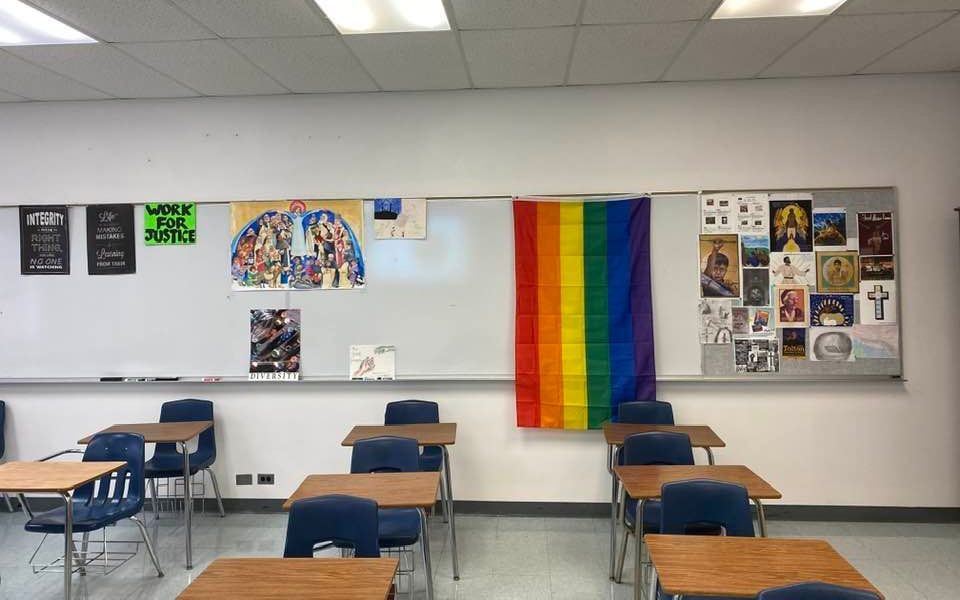I did not say anything. Students played it cool.
I heard a few students gasp in surprise when they walked into my room after Christmas break. Other students smiled quietly. Most remained indifferent. Or, as teenagers tend to do, they remained indifferent in public view. But they all had some reaction.
Over Christmas break, I had finally decided to display a Pride flag in my classroom. It was located in a part of the room where it was impossible not to notice. And it was positioned next to images of Jesus, Mary, the Trinity, and a myriad saints.
By displaying the Pride flag, I was not trying to push some agenda or indoctrinate anyone to a specific way of thinking. As a teacher, I was simply trying to encourage discussion, introspection, questions, and curiosity in my students and to challenge them to examine any biases about the limits of God’s infinite love.
I am not part of the LGBTQ community. I am a cisgender male, happily married to a woman, and we have two beautiful sons. I also am a disciple of “The Way” of Jesus. Or I try to be one despite my habitual sinfulness. Like St. Paul (whom I teach about), I have thorns in my flesh. Also like St. Paul, I truly believe that in Christ we are all fully welcomed, fully known, and fully loved by God. “There is no longer Jew or Greek, there is no longer slave or free, there is no longer male and female; for all of you are one in Christ Jesus” (Galatians 3:28).
So I displayed the flag to attempt, as St. Paul instructs, to “put on Christ” and offer unconditional love and hospitality to all my students, especially to those who are struggling with their sexual identities and gender identities.
After all, symbols, especially theological symbols, are multivalent. To paraphrase the theologian Elizabeth Johnson, theological symbols and their multiple coexistent meanings are of great importance for our common well-being or lack thereof. That is why symbols are so important for human meaning and belonging. They have multiple meanings and interpretations that coexist and help bind us together as communities.
These various meanings and interpretations reside in minds and souls of the beholder and connect them to that symbol. The symbol invites people to a shared sense of self, to participate in something larger. Some of these meanings become shared amongst a community and assist in forming group identity. They become dominant meanings through which we better understand our relationships with and connection to others.
Other meanings remain submerged within the larger meaning but are not subsumed into it. They can coexist with the dominant meaning, challenge it, augment and expand it, while remaining distinct from it. Some of these meanings remain individualized or in smaller groupings.
In Christianity, the cross is a prime example of a symbol. For the first 300 years of Christianity, it did not appear in any visual form. This was because the Romans were still crucifying people and thus the dominant meaning was terror and death, not hope and salvation. This was one reason why St. Paul spoke of the cross as a “stumbling block.”
As a symbol of death, terrorism, and Roman supremacy, the cross eventually had to be reinterpreted to mean something different. Today, in contemporary Christianity, the cross holds a surplus of meanings, often paradoxical: death and life, oppression and liberation, failure and triumph, condemnation and salvation, abuse and healing. In parishes, seminaries, and faith formation groups, few Christian symbols have incited as much heated debate in the last 40 years as the cross and its various meanings.
The Pride flag, of course, is not an ancient symbol and does not carry the same deep theological weight that the cross carries. But I think it remains a symbol that has profound theological meaning, nonetheless. The flag’s dominant meaning is one of love, validation, and celebration of LGBTQ persons who carry God’s own image in a unique way. It reminds us, like Jesus’ parables, that God is free and shows unfettered compassion and acceptance to all of God’s children; especially to those who are the most misunderstood by a faith community.
I see many of my students in the flag. I am a theology teacher who also had the privilege of accompanying a teen LGBTQ support group for a while. Just through listening and being present, I have begun to recognize the unique pain that accompanies queer and questioning youth as they seek understanding, love, and validation from family and faith communities.
I have learned how to gently remind them that the denigrating and dehumanizing words that have been cast at them from some Catholics and other Christians do not come from God. I learned to again listen to St. Augustine and realize that God’s love and God’s ways far surpass my own limited understanding. The great doctor of the church taught si comprehendis, non est Deus (if you think that you have understood, then what you have understood is not God). I must honor this.
Moreover, if God is Trinity, then community, diversity, and difference already and eternally abide within God’s “self.” As the Council of Nicaea reminded us, the Father is not the Son, the Son is not the Father, and neither are identical to the Holy Spirit. There are three very different “persons,” identified through terms of relationship, and each has a divine yearning, a divine eros for the others, that culminates in one shared ousia, one essence, as they perform an eternal dance of perichoresis with each other that has been opened to human beings through God’s incarnation as Christ Jesus. Our finite eros, as Ronald Rolheiser, O.M.I. points out, seeks its home in the divine eros and thus “our hearts are restless until they rest in Thee.”
God’s triune nature is expansive enough to encompass diverse expressions of love, joy, and eros amidst great difference, and therefore we who carry God’s triune image must have a humble yet expansive enough view of God to honor the dwelling of God’s Spirit wherever and however God chooses to “tabernacle” among us (John 1). And we must recognize and celebrate the great diversity of ways that God chooses to be known among us, including diversity of sexuality and gender identity.
As the months unfolded, the classroom Pride flag was respected like other theological symbols around the classroom. It became part of our shared space. If it fell down, one student or another would walk over and hang it back up. I have little doubt that some students dreaded seeing it, some were reassured by it that God truly does care for everyone, and others felt quietly “seen” and validated in God’s presence because of it. A symbol affects different people in different ways.
Symbols do indeed function for our common well-being or lack thereof. They are a reminder of what binds a community together, to what lofty ideals a community aspires, and what holds them accountable. In this sense, the Pride flag became a kind of theological symbol in the classroom.
Image: Courtesy of Kevin P. Considine














Add comment